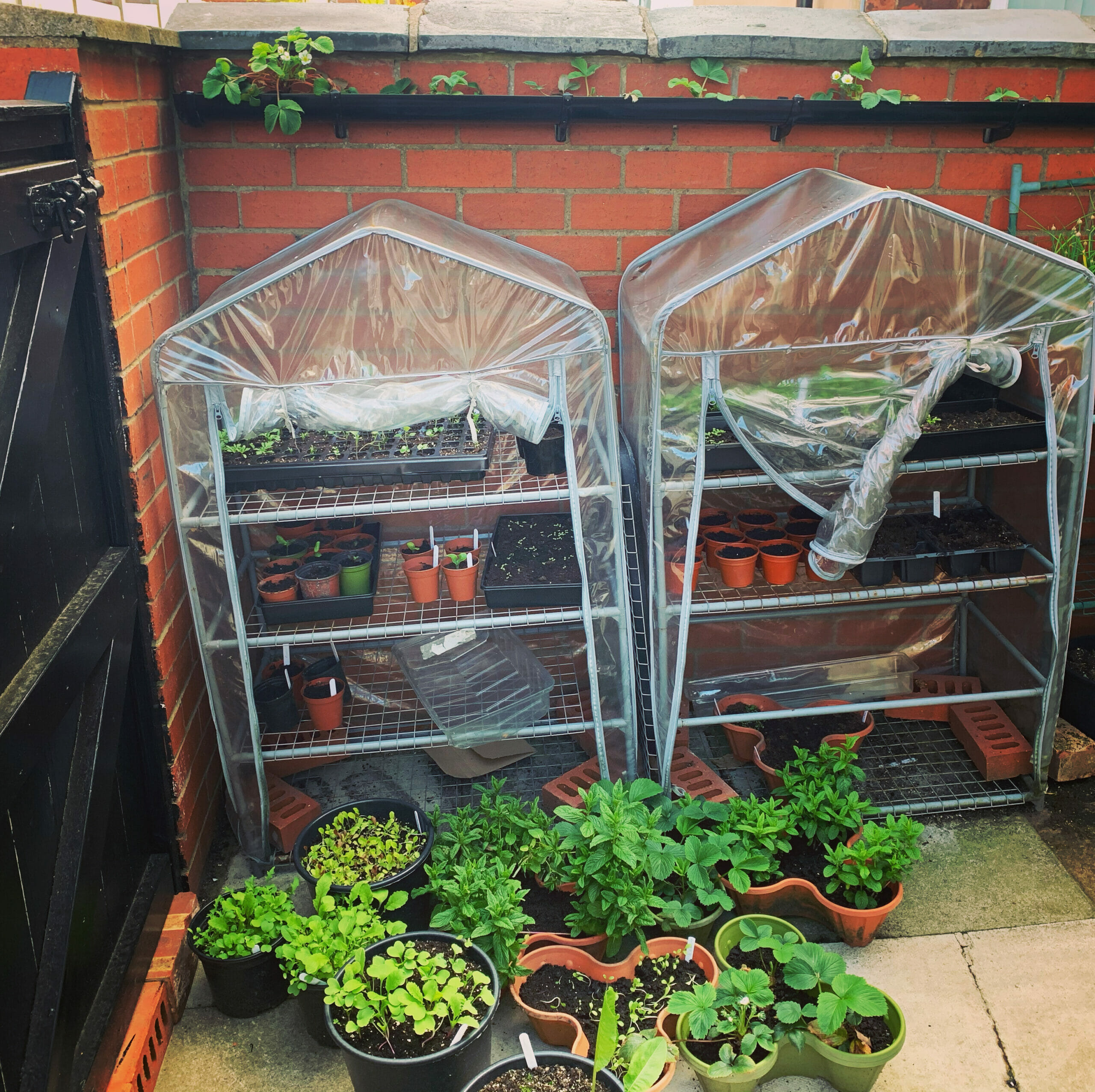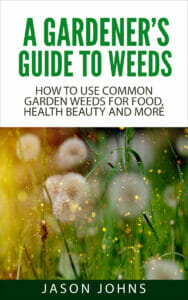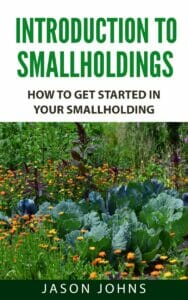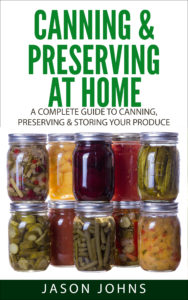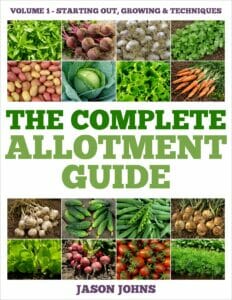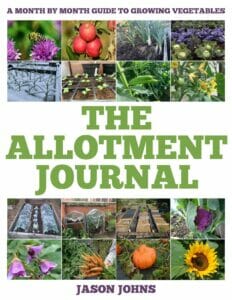May is a busy month in the vegetable garden. The days are getting longer, the weather warming and the risk of frost in most areas diminishing to close to zero. Many seedlings started in the last month or two are straining to get out of their pots, keen to be in the ground so they can really grow. Plus some early crops will even be ready to harvest now.

What To Harvest
There will be vegetables to harvest this month, and it is the start of the ‘fun’ part of running a vegetable garden. Surprisingly, there is quite a lot you can harvest, including:
- Asparagus – cut the tips when they are 5-7″/13-18cm long and no fatter than your forefinger. Use a sharp knife and cut just below the surface of the soil. Fresh asparagus is best eaten as soon as possible after harvesting, otherwise store wrapped in plastic in your refrigerator. Unfortunately, this crop cannot be left in the ground until you are ready to harvest it and must be picked when it is ready.
- Garlic – the first of your garlic can be lifted this month while the leaves are still green. They will be milder and are considered ‘wet’. Store them in your refrigerator and use them as you need them.
- Globe Artichokes – although these will be small, pick a few and use them this month as it will encourage the plant to produce more.
- Oriental Leaves – mizuna and other Oriental leaves will be ready to harvest for salads. Pick the leaves when they are small and use as soon as possible. They will store for a couple of days in plastic in your refrigerator.
- Lettuce – lettuces sown as cut-and-come-again crops can be harvested.
- Radish – some early sown radishes will be ready to harvest this month. Pull them before they grow too big and become woody.
- Rhubarb – these are best harvested when the stalks are about 12″/30cm long as larger stalks can become a bit stringy. Harvest the stalks as and when you need them, remembering not to take too much from a single plant.
- Spinach – pick as a cut-and-come-again crop. The young leaves are used in salads and the older leaves are best cooked.
- Spring Cabbage – this may be the last month you can harvest your spring cabbages. Blanch and freeze any excess for longer term storage.
- Spring Onions – the first of these may well be ready to harvest, so pick them and enjoy them.
- Spring Cauliflower – this is the last month for harvesting your spring cauliflowers. The summer ones should be ready from next month, but any excess can be blanched and frozen.
- Turnips – the first baby turnips will be ready to harvest. They are at their best when they are still small, before they grow too large and become woody. The leaves, ‘turnip tops’, can be steamed or used in stir fries.
Vegetable Garden Jobs
There is a lot to sow and plant in May, it is probably one of the busiest months for putting things in the ground, so hopefully you will have spent some time conditioning and preparing your soil for planting season.
- Brassicas – Brussels sprouts, cauliflower, cabbage and broccoli can all be planted out this month. This is the last month to get Brussels sprouts in so they are ready for Christmas. Sprouting broccoli and calabrese can be planted until July for harvesting over winter and into the New Year. As these plants can grow quite large, give them plenty of space.
- Broad Beans – tall plants need to be staked, particularly in windy areas, to prevent the plants being damaged in the wind or by the weight of the pods.
- Celery – plants that has been started indoors can be planted out, though take care to protect them from the first.
- Chillies/Peppers – best sown indoors, though in many areas it will be too late for them to grow to maturity this year. If you are keeping them under cover, they can still be planted for a later harvest. Cucumbers are sown indoors, though can be sown outdoors in sheltered areas under a cloche or in a cold frame. If it has warmed towards the end of the month, cucumbers started off indoors can be moved outside.
- Florence Fennel – sow outdoors if the soil is warm enough.
- French/Runner Beans – sow outdoors if the soil has warmed and the risk of frost passed, otherwise continue to start them off indoors for planting out towards the end of the month and start of June. Young seedlings can be protected from cold snaps with plastic bottles or cloches.
- Globe artichokes – feed with a high potash feed and covered with a rich, organic mulch.
- Kohl Rabi – sow outdoors, providing the soil is warm enough.
- Leaf Vegetables – leafy vegetables such as spinach, kale, chard and the Oriental leaves including mizuna, mustard greens and Chinese broccoli can all be sown outdoors, though keep your horticultural fleece to hand to cover them on cold nights.
- Lettuce – sow directly, though if the weather is chilly, sow them under cover. Most herbs can be planted directly, though tender herbs such as basil will benefit from protection from the cold.
- Peas – both maincrop and sugar snap peas can still be planted outdoors, though be prepared to protect them from the cold with cloches if necessary. Provide supports to keep them off the ground and protect them from mice, slugs and snails
- Potatoes will be started to show their heads above soil. Keep earthing them up and covering them to prevent the tubers being exposed to light and turning green. If there is a risk of frost, earth up or otherwise protect your potatoes as the stalks and stems are not frost harder and will die off if they get too cold.
- Root vegetables – all root vegetables including turnips, swedes, beetroot and carrots can all be planted outdoors now. If it is still a bit chilly, cover the beetroot seeds with fleece to aid germination.
- Seeds – those sown last month such as carrots, beetroot, lettuce and parsnip will benefit from being thinned out. The thinning can be eaten in green salads.
- Squashes – all squashes including pumpkins and courgettes are all planted indoors or under glass this month to improve germination, then planted out next month.
- Sweetcorn – plant directly outside. Remember to plant this crop in blocks rather than rows to improve germination. Young seedlings benefit from protection from frost and slugs too.
- Sweet Potatoes – if the weather has warmed, these can be planted at the end of the month. This is also the last month to get your seed potatoes in the ground.
- Weeding – keep the weeds down around your onions and garlic. They hate competition and can quickly get crowded out by faster growing weeds.
Fruit Tree/Bush Jobs
The fruit garden will still be quiet this month, but there are plenty of jobs to get on with, as there always is!
- Apple/Plum – pheromone traps can be hung in apple and plum trees to reduce the risk of codling moth and plum fruit moth.
- Cape Gooseberries – plant out this month, but be prepared to protect the plants from frost.
- Cherry/Plum – these can be pruned this month. Trained trees such as peaches, nectarines and apricots can be thinned or new shoots can be tied in. On trained apples and pears, leaders and side shoots can be shortened.
- Fruit Bushes – weed around the base and a good mulch applying. This will help the soil retain moisture and suppress weed growth.
- Gooseberries – thin fruits out so that those left on the plants can grow larger. These are unlikely to be mature enough to eat raw, but can certainly be cooked. Also check the centre of your gooseberry bushes for signs of gooseberry sawfly caterpillars. These will strip your plants of leaves and reduce your yield significantly. Remove the caterpillars by hand or use an appropriate treatment.
- Melons – start off indoors as it will be too cold in many areas to plant outside. Keep them warm and sheltered from the frost.
- Raspberries – check for suckers and new shoots, as they can be a little over-eager. Pull them up or cut them off so that your raspberries don’t get overcrowded.
- Rhubarb – young plants, started from seed, can be transplanted outdoors, as can strawberries.
- Strawberries – remove runners from strawberries so they concentrate on producing fruit. Keep the plants covered in the cold to help the plants flower earlier. Remember to remove the cloches during the day to allow for pollination. New strawberry plants need the flowers pinching off so that they do not produce a crop in their first year and can fully establish themselves.
General Jobs
There are plenty of things to do at your allotment, though keeping on top of weeds and pests is likely to be one of them as they are all emerging after the cold of winter. Make sure you keep the weeds down around your vegetable plants so they don’t crowd out what you are trying to grow. Some of the jobs to do this month include:
- Frost Alert – keep paying attention to the weather news this month. Although the weather is warming, there is always the risk of a sudden frost. If the temperature looks like it will drop too much, then cover your tender plants to protect them from cold/frost damage.
- Tender seedlings – start hardening off and plant out this month once the risk of frost has passed. Be prepared though to go outside if there is a risk of frost and cover them to protect them.
- Watering – keep watering young plants and seedlings, particularly those that are kept under cover or in a greenhouse as they do run the risk of drying out.
- Weeding – keep weeding as the weeds will be bursting into life too this month. Use your hoe to take the heads off the weeds and this should help reduce the problems with weeds later in the growing season.
Greenhouse and Polytunnel Jobs
The greenhouse will be a hive of activity this month as your seedlings continue to grow and main crops such as tomatoes and cucumbers are planted. Jobs to do include:
- Potting on – tomatoes, cucumbers, peppers, chillies and aubergines can all the planted on into larger containers now. Put supports in place while the plants are still young to prevent damage to the roots later on.
- Repotting – any plants that are growing too big for their containers need to be repotted into larger containers so they can continue to grow until they can be planted out.
- Tidying – keep your greenhouse tidy and clear of any debris to avoid pests lurking in it. Because it is a busy time of year, it is very easy for your greenhouse to get cluttered and fill up with spilt soil and other odds and ends.
- Ventilation – open vents, windows and doors during the day to encourage pollinating insects in and for the air to circulate.
- Watering – keep plants, particularly seedlings, well watered as they can dry out and wilt very easily in the warmer weather.
